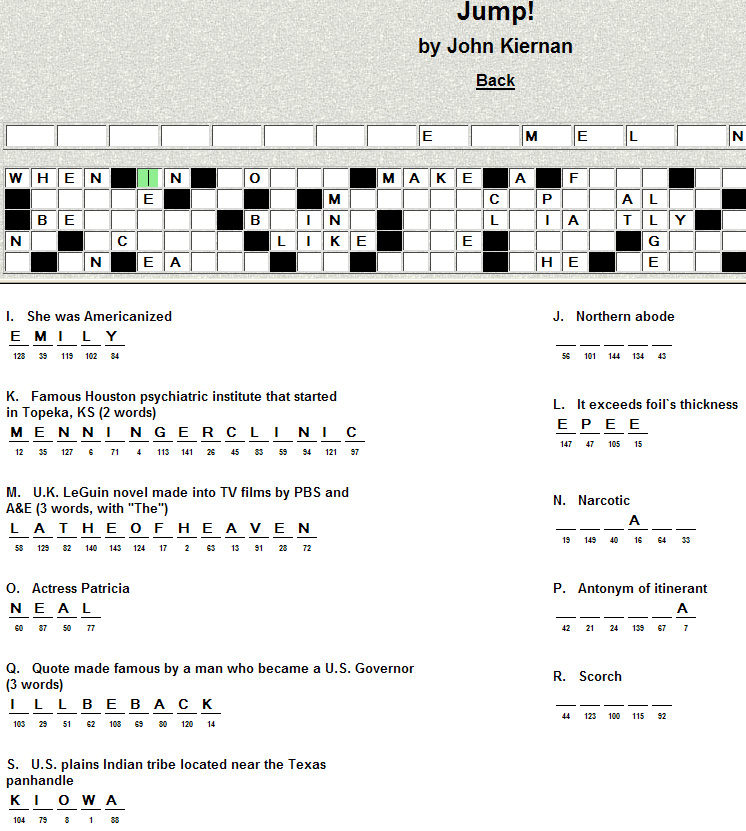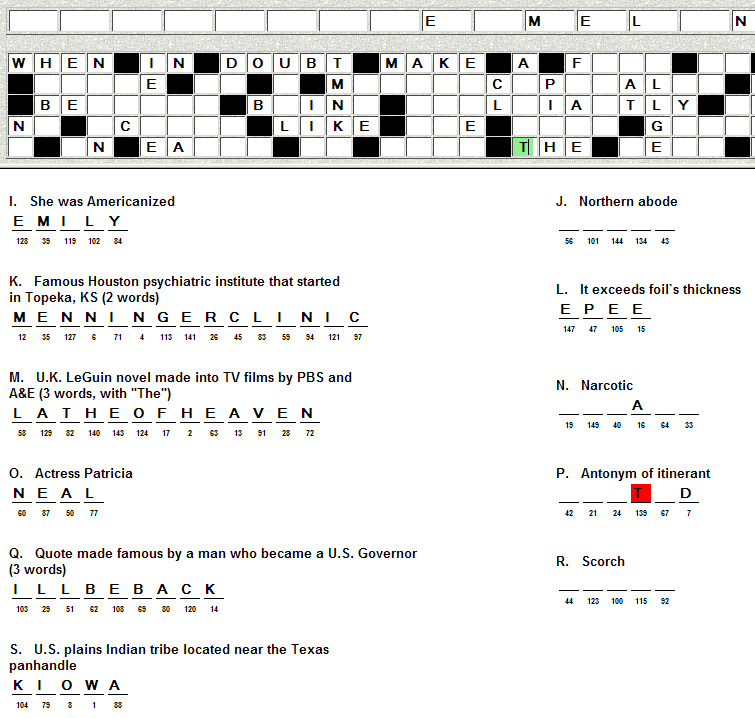How to solve an Acrostic Puzzle
|
What are Acrostic puzzles? The fun thing about Acrostic puzzles is that they are not just puzzles that require trivia knowledge. I have solved many a puzzle without knowing some of the key answers to the clues given. But I do have a logical mind -- which helps immensely. For those who are not familiar with the puzzle, you fill in words based on the clues given on the bottom. Entering these letters then fills in the corresponding letters on the top grid. (In the past with printed puzzles, there would be numbers in the grid boxes on the top to show you how each pair were related.) When the solver has finished entering the words on the bottom, the grid on the top will be complete, and will spell out a quotation. Subsequently, the first letters of the words on the bottom grid will spell out the author's name and sometimes the work from which it was derived. In NetCrostics, all of that tedious "back and forth" entering is eliminated as the system will automatically fill in corresponding letter, no matter whether you are entering it on the top or the bottom. Furthermore, the system also fills in the author name and quotation on the top line as well! All of this is easier said than done, right? How to solve the Acrostic puzzle To begin with, I try to answer the words in the bottom area of which I am reasonably certain. In the example below, some words have only one possible answer, if you know it. Things like titles, names, geographic locations probably require the knowledge about the word to which the clue points. 
So, having entered the words and letters above, I have also then filled in a number of letters on the top grid as well. Having done that, I can then look at the grid and see if any of the letters filled in give me a hint to what some other of the words on the top might be. Take a look at the image above for a moment. Do any of the partial words in the top grid seem like they are familiar words with one or two letters missing? To me, the one that jumps out the most is in the first word in the top grid. The only answer would seem to be "when". The next word is a two letter word ending in "N". This would give me three possibilities: "an", "in", and "on". We can eliminate "an" because the second letter of the word following it is an "O". Since "an" must be followed by a word starting with a vowel, we can surmise it isn't "an". That leaves "in" and "on". While it is possible that it is "on" (as in "When on vacation", or the like), my "gut" tells me it will be "in", as in the familiar phrase "when in doubt". And when I look past the two letter word to the next word "doubt" fits perfectly. While I am at it, let me fill in the "T" of "the" on the bottom line. When I "_HE", in a word, there is a good chance it is "the" (although it could be "she", so I should try to figure out if there is any other mentions of "she" within the puzzle. Is it possible I am wrong about these assumptions? Sure. But unless you're one of those people who insists on doing crossword puzzles in pen, it's easy enough to back out any words guessed incorrectly. Thus, if I add in the letters I have guessed at, I get the result shown below.  Obviously, I can keep going on the top. In the middle of the grid (above "like"), I
see a word that my experience tells me will probably end with "ing". That means it
could be "being" or "bring". But we'll stop on top for the moment, and drop back
down to the bottom.
Obviously, I can keep going on the top. In the middle of the grid (above "like"), I
see a word that my experience tells me will probably end with "ing". That means it
could be "being" or "bring". But we'll stop on top for the moment, and drop back
down to the bottom.Having inserted the letters in the top grid, I see on Word P that I have filled in a few letters. Without continuing on to solve the whole puzzle, I would say that there is a good chance that the word ends with "ed". I can then move on to the words to which I think I know the answer. As I enter them, I look to see if the entry I am making works (in the top grid) with the letters entered of which I am certain. If I enter "torch" for the clue "scorch", I quickly see I have put a "TC" combination in for a word, as well as making a word ending in "VH". Chances are that I have mis-guessed. Back to the drawing board! By the way, you can also enter letters in the upper grid (the one with the author name and work). Entering letters there will fill in letters in BOTH the top and bottom sections. The point in the above exercise is to show that solving Acrostic Puzzles is like getting a boulder rolling downhill. It's pretty hard to start the process, but it gets progressively easier as you go along, as each answer in one place helps give you clues in the corresponding other part of the puzzle. At any rate, there's a quick "How To" about Acrostics. As you do more and more puzzles, you'll often begin to recognize large words with only one or two letters filled in. You'll also be able to apply logic to the puzzle. If there are a number of one letter words, the question becomes "Is this a first person quote?" If not, those one letter words are probably "A". Look for word suffixes like "ING", "ED", and "LY". Every little bit will help. If you want to continue with the puzzle shown in this example, it is "Jump!" from December 2004 in my puzzle group. -- John Kiernan, NetCrostics |